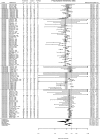Do antimicrobial mass medications work? A systematic review and meta-analysis of randomised clinical trials investigating antimicrobial prophylaxis or metaphylaxis against naturally occurring bovine respiratory disease
- PMID: 28830074
- PMCID: PMC7108556
- DOI: 10.1093/femspd/ftx083
Do antimicrobial mass medications work? A systematic review and meta-analysis of randomised clinical trials investigating antimicrobial prophylaxis or metaphylaxis against naturally occurring bovine respiratory disease
Abstract
A distinct difference between veterinary and human medicine is the routine use of antimicrobial mass medications (prophylaxis, metaphylaxis) to healthy individuals. The need for antimicrobial mass medications is based on beliefs that group/s of animals will contract a bacterial disease (i.e. morbidity) and/or die (i.e. mortality). Bovine respiratory disease (BRD) represents the major indication for cattle antimicrobials worldwide. The objectives were to perform a systematic review and meta-analysis of randomised controlled clinical trials (RCTs) for naturally occurring BRD investigating antimicrobial prophylaxis/metaphylaxis to prevent morbidity/mortality. In total, 58 publications met the inclusion criteria summarizing 169 individual RCTs, spanning 50 years (1966-2016). Antimicrobial prophylaxis and metaphylaxis demonstrated moderate, yet highly variable relative risk reductions in BRD morbidity. These were dependent on the antimicrobial classes used, dependent on metaphylaxis definition, BRD attack rates and duration of the RCTs. Best relative risk reductions were from broad-spectrum critically important antimicrobials, or combinations. BRD prophylaxis/metaphylaxis represents major antimicrobial consumption for highly variable short-term gains in absolute risk reduction of morbidity/mortality. Despite widespread use of prevention products, the need for antimicrobial mass medications should be re-evaluated since the underlying problem is more likely the segmented infrastructure of the feedlot and veal calf industries compared to the disease itself.
Keywords: antimicrobial; bovine; metaphylaxis; prophylaxis.
© FEMS 2017. All rights reserved. For permissions, please e-mail: journals.permissions@oup.com.
Figures





References
-
- Albak C, Bradstock L, Cruise L. Prophylactic treatment of feedlot calves at processing with a long-acting oxytetracycline. Bovine Pr 1986;21:192–4.
-
- Anonymous. Comparative efficacy of DRAXXIN™ or Micotil® for the control of respiratory disease in cattle at high risk of developing undifferentiated bovine respiratory disease. Pfizer Animal Health Technical Bulletin 2005.
-
- Anonymous. Metaphylactic use of DRAXXIN® (tulathromycin) in weaned dairy calves at high risk for infectious respiratory disease. Technical Bulletin DRX13045 2013.
-
- Bechtol DT, Johnson EG, Lechtenberg KF et al. . Multi-center field dose confirmation study of a single injection of 4 mg/kg body weight of 20, 23-di-piperdinyl-mycaminosyl-tylonolide (tildipirosin) in cattle at high risk for developing bovine respiratory disease. Study Number 2052-009-00. 2012;NADA 141–334:Freedom of Information Act Summary.
Publication types
MeSH terms
Substances
LinkOut - more resources
Full Text Sources
Other Literature Sources
Miscellaneous

